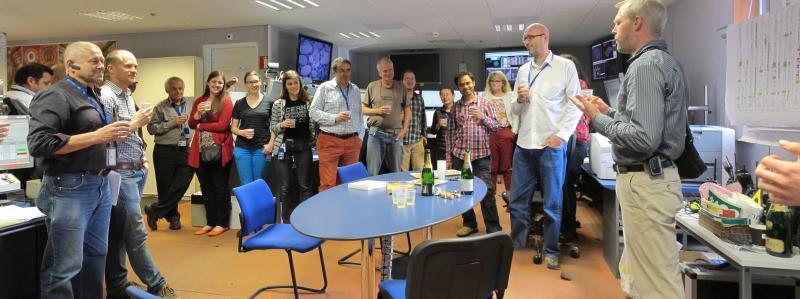Last week, the (many) visitors that came to Point 5, the location of the CMS Experiment in the LHC ring, had the opportunity to see not only the underground experimental cavern, but also how the data-taking is performed from the control room. This is not really common because when we are taking collision data, the detector is not accessible, and when it is accessible, it is because we are not taking data.
What happened last week then?
We had the "April Global Run" (AGR), a technical run in which we took cosmic data (meaning data from cosmic rays, not collisions) in order to make sure all the systems and the detector are ready before the next update of the Data Acquisition system.
We are currently in the middle of the "Long Shutdown 1 (LS1)" of the LHC, which means that we do not have collisions. The full accelerator chain is undergoing different maintenance, renovation, and upgrade activities towards the next run, when the LHC will get very close to its design collision energy.
The experiments are also using this time without collisions to do some maintenance and repairs and get things ready for the higher energies. Work has been ongoing since the LS1 started, in February last year, and this global run was very useful to check how things are going.
During a global run the control room of CMS is full of people, experts from the different sub-detectors, run coordination, and, as in any moment during data-taking, the shift crew. The shift crew is composed of five people that control different areas of the central functioning of CMS. The crew is renewed every eight hours: morning, evening and night. There's a Detector Safety shifter (DCS), who is responsible for monitoring the status of the controls of the experiment (voltages, temperatures etc.), check for any alarms and for other technical things. The Data Quality Monitoring (DQM) shifter, who, as the name suggests, checks the quality of the recorded data. The Trigger shifter, who controls the different filters used for recording interesting data. The Data Acquisition (DAQ) shifter is in control of the run control system, starts and stops the recording of the data, and knows when something is failing or in error. Finally there's the shift leader, who must coordinate the overall activities of the shift crew and is responsible for the safety.
During the AGR, the main goal was to record data with all the possible systems included, something that, after many months of works, is not an easy task. The DAQ shifter labour is particularly intensive. Constantly, new things need to be included or excluded from the global run (so the experts can work on different things on them). New hardware was tested this week, as well as new configurations. Many tests were performed and invaluable information was obtained even from the failures. Some milestones were achieved, for example the Tracker ran cold (−15 °C) for the first time on Wednesday.
On Friday, the Global Run officially finished and at the end of the afternoon we had our traditional "farewell drink". The experts then started to put some of the different sub-detectors in "safe mode". CMS still recorded data during the night, but with the DAQ unattended.

The views expressed in CMS blogs are personal views of the author and do not necessarily represent official views of the CMS collaboration.
